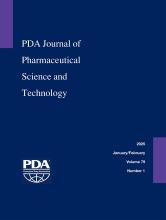Abstract
Visual inspectors′ ability to detect foreign matter in injections must be qualified for each product type or bracketing group, as stated in the United States Pharmacopeia <1790>. The common defect criterion is ″visible″ However, this qualitative lower rejection limit is based on the premise that the nature of human inspection at one site is globally comparable to that at all other sites. If not, the ″visible″ foreign matter can vary among inspector groups for each product, leading to quality differences between sites. Inspectors are trained and qualified using ″visible″ foreign matter samples from their site; therefore, inspectors′ ability to detect foreign matter can differ due to different standards. Japanese pharmaceutical companies import injections and perform secondary visual inspections because variations in ″visible″ ability arise due to individual differences among regions. Currently, there is no universal method for comparing ″visible″ rejection zones among manufacturing sites for different products because product-specific standard samples for qualifications cannot be universalized. Therefore, instead of comparing the product-specific ″visible″ standard sample, this study proposes a novel universal particle standard challenge kit to compare sites' or inspectors' inner ″visible″ detection ability. Our results suggest that the proposed kit could evaluate the comparability of ″visible″ at each site and for each inspector but not on sites′ ″visible″ standard samples. The primary challenge in implementing a universal standard lies in the inherent bias of inspectors already acclimated to specific products. This study found that an inspectors′ foundational ability can be evaluated by canceling the bias via rapid and effective training in cases of simple standard samples. Our results suggest that using a universal standard kit to assess an inspector′s fundamental ability to detect ″visible″ foreign matter is feasible. The study does not aim to replace the inspectors′ product qualifications but to compare their inner ability for risk assessment.
- Received October 15, 2023.
- Accepted March 5, 2025.
- Copyright © 2025, Parenteral Drug Association
PDA members receive access to all articles published in the current year and previous volume year. Institutional subscribers received access to all content. Log in below to receive access to this article if you are either of these.
If you are neither or you are a PDA member trying to access an article outside of your membership license, then you must purchase access to this article (below). If you do not have a username or password for JPST, you will be required to create an account prior to purchasing.
Full issue PDFs are for PDA members only.
Note to pda.org users
The PDA and PDA bookstore websites (www.pda.org and www.pda.org/bookstore) are separate websites from the PDA JPST website. When you first join PDA, your initial UserID and Password are sent to HighWirePress to create your PDA JPST account. Subsequent UserrID and Password changes required at the PDA websites will not pass on to PDA JPST and vice versa. If you forget your PDA JPST UserID and/or Password, you can request help to retrieve UserID and reset Password below.






